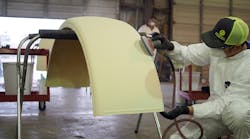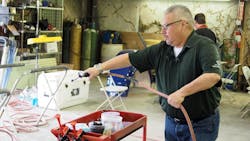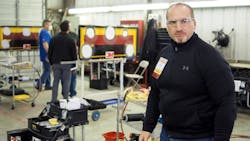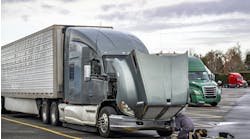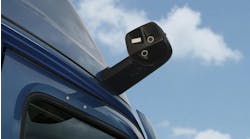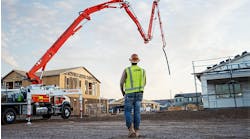SAN ANTONIO. Dick Schmidt will tell you that 10 years ago, when a truck owner needed body repairs and/or paint work for their equipment, it had to be done with high quality – even if it meant taking extra time to do it.
Nowadays, however, while the demand for quality remains the same, most truck owners want it done as fast and as cheap as possible – putting more pressure upon two technician disciplines that are already in short supply.
“Because body filler and paint are so expensive these days, waste is a big concern – especially since truck customers want it fixed faster and cheaper so they can get their vehicle back on the road making money,” Schmidt, director of collision center operations for Rush Enterprises, told Fleet Owner here during the 2016 Rush Technician Skills Rodeo.
“And it’s getting extremely hard if not harder to find these [body and paint] technicians compared to regular service techs,” he added. “It’s an almost old school [technician] discipline; it’s manual labor. Most young guys just don’t want to do this. They’d rather work with computers.”
Schmidt said Rush operates some 26 collision repair facilities within its network of more than 100 dealerships; facilities spread out from “Los Angeles to Florida and Chicago down to McAllen, Texas,” he noted.
The company employs some 250 to 300 body repair and paint technicians and five from each discipline – for a total of 10 technicians – are competing among the 165 semi-finalists at this year’s Rodeo, which is being held at the Henry B. Gonzalez Convention Center in downtown San Antonio.
Complicating matters in the “real world” outside of the Rodeo are the cost pressures now being placed on truck body repair and painting services, Schmidt said – meaning technicians in those specialties must be able to work fast without sacrificing quality or overusing body filler and paint supplies, which drives up repair costs.
For example, Marcy Fernandez, North American fleet manager for the commercial transportation segment at paint-maker Axalta, said some high-end truck paints can cost $3,500 a pint and with the large amount of surface area on a Class 8 truck to cover, overusing even a little bit can make the job unprofitable in a hurry.
“It’s not like the automotive world, where paint is layered on coat by coat, which can help blend out imperfections,” he pointed out. “Because trucks are so big, we must take a ‘one-and-done’ approach – and applying one clean coat requires a [paint] technician to make the [paint] mixture just right and apply it with even-handed discipline.”
Being forced to apply two coats due to a mistake can be a bottom-line buster, Fernandez added. “That turns a $1,400 job into a $3,000 job; you just can’t afford to use a quart or two extra anymore,” he stressed. “That’s why we also say there’s a little ‘magic’ needed when you are applying high-solid paints in one coat. Because if it is not done just right, you’ll see the imperfections.”
John Spoto, national heavy duty commercial fleet manager for 3M, noted that the same pressures are being felt by body repair technicians, too.
“For example, when you are repairing dents in this competition, we’re looking not just at the final appearance of the repair, but how much material did you use and whether you followed the proper procedures,” he emphasized. “Anyone can take a gallon of filler to repair a dent. But that is adding cost to the repair, and if there are lots of sanding scratches, it’ll require more paint to cover [the repair] as well.”
Part of the problem, though, is that such “specialty” technicians as a group are older than the main population of truck technicians, said Spoto – averaging around 53 years in age.
Thus he feels it will be doubly hard finding new entrants to this particular technician specialty because not only must they work primarily with their hands – something that’s becoming a “lost art” in the vocational schooling realm – but they must also bring a high degree of “mental focus” to the job as well.
“Safety is the most important variable; you must make a repair that is safe and that will be durable,” Spoto stressed. “It is all about the will to improve yourself and the ability to apply your knowledge.”
In many ways, he said the “mind must overcome the hands” in terms of learning for instance how much force to apply, or not to apply, when hammering out dents so as not to overstress the metal.
Rush’s Schmidt added that body repair is becoming more complicated as more and different fiberglass and plastic materials are being used on trucks – just like what’s occurring in the automotive world – in lieu or steel and aluminum.
“They are of better quality and more durable but as they [the OEMs] change the product, we need to change our repair and paint procedures,” he said. “What doesn’t change is the need for greater productivity, efficiency, and safety, while ensuring minimum waste of material.”
